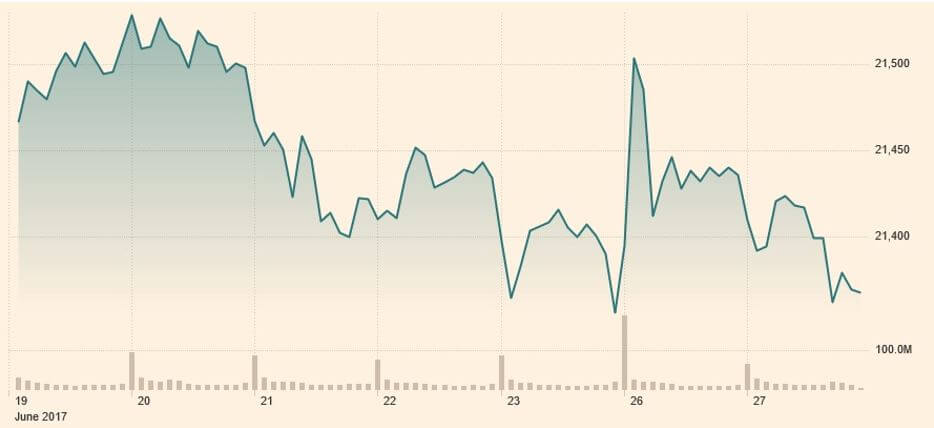
The last week of June has been rather bearish for Wall Street. The Dow Jones Industrial Average has retreated from over 21,500 to its current level of 21,367.58. While still impressive, the recent losses have dampened expectations somewhat. The S&P 500 index has also performed in a similar fashion, declining from the 2,450 support level to its current level of 2,425.63.
And the tech-heavy NASDAQ composite index is down from a week high of 6,290 to its current level of 6,161.73. The weekly performance of Wall Street bourses should not be perceived as a barometer of the overall strength of these indices over 1 year. For example, the Dow is up 24.66%, the S&P 500 index is up 21.25%, and the NASDAQ composite index is up 34.11%.
This begs the question: What drove the indices lower towards the end of June?
There are several reasons why US equities markets are facing a risk-off approach by traders. For starters, oil prices have hit fresh new lows, and this typically results in a selloff of energy company stocks on the indices. By Tuesday, 27 June, oil prices have rebounded slightly, yet markets remained bearish. This was attributed to declines in telephone companies, utility companies and technology companies.
The USD came under some fire with speculation that the European Central Bank (ECB) is considering hiking interest rates in the near future. Currently, the official interest rate in the euro area is fixed at 0.00% for its main refinancing operations and -0.40% for its deposit facility. The marginal lending facility interest rate is currently 0.25%. The European banking sector struggles immensely under a negative interest rate setting, and the prospect of a rate hike is exactly what the banking sector needs to rally.
EUR Gains Ground After ECB Optimism
The slowdown on Wall Street was precipitated by a massive fine imposed on Alphabet by the EU. A $2.7 billion fine was slapped on Alphabet Inc., the parent company of Google. After that news broke, the stock price of Google plunged 2.63%, losing $25.04 to trade at $927.23 per share. According to regulators, Google promoted its own shopping services over those of competitors. Both the EU and the European Commission will monitor Google and respond to any appeals that have been filed. Further legal action may still be taken against the company.
Meanwhile, consumer confidence levels and home prices in the US started circulating through the markets. While home prices appreciated by 5.7% across the country in April, it is a slower rate of increase than February and March which gained 5.9%. The price of WTI crude oil is currently $44.27 on the Nymex and Brent crude oil is trading at $46.72 on the ICE. The EUR made some ground against the GBP, the USD and the JPY on the back of comments that Mario Draghi (president of the ECB) is increasingly optimistic about the European economy.
The risk-off approach adopted to equities markets is nothing new. According to Hamish Goldwater, a Lionexo trading options expert, “The European Central Bank (ECB) is getting ready to unwind its significant asset holdings. However, the pace and scope of this will determine how traders react in the markets. A gradual policy of unwinding will have a slow and steady effect on currency markets and indices.”
However, a dramatic selloff will create increased volatility in markets and negatively impact the EUR, the CAC40, the DAX 30, the Ibex 35 and others. These CBOE volatility index is currently at 11.09, for a change of +1.19. The Chicago Board Options Exchange index measures sentiment vis-à-vis market expectations on volatility with respect to the S&P 500 index. The volatility index spiked 11.82% on Tuesday, 27 June, as greater uncertainty crept into markets. Where to next is a matter than speculators are ready to tackle!
